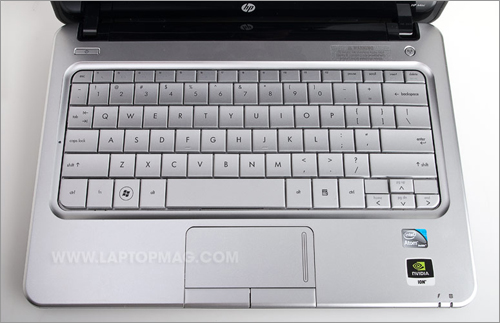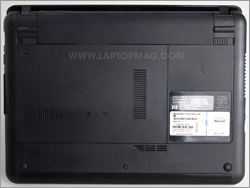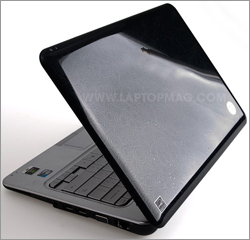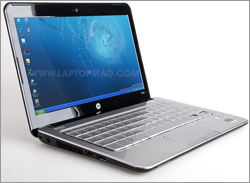Laptop Mag Verdict
HP's Ion-powered netbook delivers strong graphics performance and long battery life in a sleek package.
Pros
- +
Excellent graphics performance
- +
Stylish design
- +
Good battery life
- +
Loud speakers
Cons
- -
Touchpad has too much friction
- -
Slow boot time
Why you can trust Laptop Mag
When is a netbook not a netbook? PC makers have been looking to expand the definition of these systems by outfitting them with larger screens and bigger batteries, but one constant has remained: a low-powered processor that limits their use to surfing the Web, checking e-mail, editing documents, and watching standard-def video. Then along comes Nvidia's Ion, a graphics processor that will allow netbook users to go from merely consuming media to creating it. The HP Mini 311 ($399) is the first Ion-based netbook to hit the U.S. market, and we're impressed by its ability to deliver high-def video playback, better gameplay, and faster video editing. Even better, you get the long endurance we've come to expect from this category.
Design
The Mini 311 combines elements from several of HP's larger notebooks: its black lid (also available in white) bears HP's Swirl pattern. A black speaker grille unobtrusively lines the front edge of the chassis, and the silver deck, keyboard, and touchpad remind us of the company's Pavilion Series.
Measuring 11.4 x 8.0 x 1.2 inches, the Mini 311 is roughly the same size as the Acer Aspire 751h and the MSI Wind U210. We were glad to see that HP's battery is well-integrated with the chassis, and doesn't jut out the back. With a weight of 3.2 pounds, the 311 isn't much heavier than other 12-inch netbooks, which weigh around 3 pounds.
Keyboard and Touchpad
The 311's square silver keys practically abut each other, and are slightly indented to provide a resting place for your fingers. Typing on the keys was comfortable, and we were up to our normal speed almost immediately. Despite the keys' smooth surface, our fingers did not slip.
Below, the silver touchpad is amply sized for an 11-inch netbook. At 3.3 x 1.5 inches, it's almost the same size as that on the Toshiba mini NB205. Unlike the NB205, however, the 311's touchpad has too much friction, an issue we've had with other HP notebooks. The two mouse buttons are also decently sized, but we found them to be slightly stiff to press towards the outer edges.
Sign up to receive The Snapshot, a free special dispatch from Laptop Mag, in your inbox.
Click to enlarge
Display and Audio
The 11.6-inch display on the 311 has a resolution of 1366 x 768, which makes it easier to view Web pages and documents without having to scroll. The glossy display has excellent horizontal viewing angles; we could see the screen clearly from nearly 90 degrees to either side, though tilting the screen forward resulted in a rather quick image reversal.
Along the front edge of the system is a black speaker grille that hides Altec Lansing stereo speakers; they provide better sound than we're used to from netbooks. While listening to Oasis' "Live Forever," sound was on the tinny side, but we heard much more bass than is typical of systems this size. Still, they were adequately loud; we could hear them from a few feet away without straining.
Ports and Webcam
Click to enlarge
Click to enlarge
There's no surprises when it comes to the port selection on the Mini 311. On the left side is a USB and HDMI port; on the right is Ethernet, VGA, two USB, headphones, and a 3-in-1 memory card reader.
Performance
Click to enlarge
The Mini 311 uses a 1.60-GHz Intel Atom N270 processor and 1GB of RAM, as is typical of just about every netbook. Where it differs is the GPU: Instead of an integrated Intel chipset, the 311 has an Nvidia Ion LE GPU. While not as powerful as the entry-level Nvidia graphics chips seen on larger systems, the Ion LE still provides a measure of performance far and above all other netbooks. On PCMark05, which measures overall system performance of XP laptops, the 311 scored 1,917, which is almost 500 points above the current netbook average of 1,423. To put this in even greater perspective, the highest netbook score we've ever seen on that test is 1,697 for the Dell latitude 2100 ($394).
Needless to say, we were able to perform everyday tasks easily; we simultaneously had several tabs open in Internet Explorer, wrote this review in Microsoft Works, and downloaded games from Steam without a hitch.
Still, when it comes to CPU-intensive tasks, the 311 is pretty much like any other netbook. In Geekbench, the Mini 311 scored 888, which, while 62 points higher than average, was beat by the Gateway LT3103u (902) and Toshiba mini NB205-N210 (920). When watching an episode of Community and The Simpsons streamed through Hulu (a Flash-based player that does not yet take advantage of the GPU), video was choppy, and not in sync with audio. This should be rectified somewhat with the advent of Flash 10.1, which will take advantage of the graphics chip.
The 5,400-rpm, 160GB hard drive was decent, duplicating a 4.97GB folder of multimedia files at a rate of 15.6 MBps, which is a hair above average. Boot time (1 minute 44 seconds) was very slow; for netbooks, 55 seconds is the average.
Graphics Performance
The Mini 311 produced an even more impressive score in 3DMark06 (which measures graphics performance): 1,386. That's more than 1,280 points above the netbook average. The only netbook to beat this score was the ASUS N10Jc, and that machine had switchable Nvidia graphics. The only other system that comes close is 1130 points away--the AMD-powered Gateway LT3103u.
Compared to ultraportable notebooks with Intel's integrated graphics, the Mini 311's 3DMark06 score trounces the Intel GMA 4500MHD graphics inside the $699 MSI X340 (643) and the Intel GMA X4500MHD graphics inside the $799 ASUS UL30A (760). In fact, the Mini 311's score is 501 points better than the overall ultraportable average, and is almost identical to the latest MacBook Air ($1,995).
HD Video Playback, Video Editing
Click to enlarge
We output a 1080p MPEG-4 trailer (Cloudy with a Chance of Meatballs) via HDMI from the system to a 32-inch Samsung HDTV. The Ion-powered netbook held up well, delivering satisfactory detail and great color. We saw only a few instances of motion blur, but the clip took 30 seconds to cue up. On the other hand, when we played the same clip on a Dell Mini Inspiron 10 (with an HDMI port), the action stuttered so much that it looked little better than a slideshow.
Watch the HP Mini 311 and Dell Mini Inspiron 10 output 1080p.
[flq:543aeb18aab74fa7aef8fda0ab26dc3e]
Another area where Ion is supposed to shine is video editing. The typical netbook takes about half an hour to transcode a 114MB file from AVI to MPEG-4 using HandBrake. Using only the Share feature in vReveal, a program that can tap into Ion's graphics muscle to speed up transcode times, the HP Mini 311 converted the same file in 6 minutes and 14 seconds. That's approximately five times as fast. The average ultraportable notebook takes 14:16; so in this case Ion is more than twice as fast as ULV-based notebooks with Intel graphics. Of course, when we ran the transcoding test on the 311 using HandBrake--a program that doesn't use the GPU for transcoding--the system finished in a much more pedestrian 29:11.
Gaming Performance
So Ion vastly improves graphics performance and provides a boost to overall performance. But can an Ion netbook handle gaming? We ran the Far Cry 2 benchmark on the Mini 311, something we don't even bother to do on other netbooks. With the resolution set to 1024 x 768, the machine averaged 12 frames per second. That's 4 fps above the ultraportable average, and well above the ULV dual-core ASUS UL30 and Aspire Timeline 3810T (5 and 3 fps, respectively). It should be noted, though, that in order to get even those 12 fps, the effects had to be set to low; the benchmark wasn't able to complete the test with eye candy turned up at its native resolution of 1366 x 768.
While 12 fps is far from stellar (frame rates in the high 20s and above are considered playable), Ion provides better performance in mainstream games. Playing Spore with the resolution set to 1088 x 612 and effects set to medium, we averaged 28 fps while swimming around in the primordial stew; everything from the opening animation on rendered smoothly. We were also impressed with how the Mini 311 was able to handle World of Warcraft. With the resolution set to 1366 x 768, we were able to run through the forest, killing wolves without a problem; we saw an average frame rate of 36 fps.
As with Far Cry 2, Call of Duty 4 showed the limits of Ion's power; we averaged 11 fps (as measured by fraps) with the resolution at 1024 x 768. The cut scenes at the beginning of a level were jumpy and paused, and gameplay was choppy; we found it hard to aim accurately. When we set the resolution to 640 x 480, however, action was much more smooth, and we measured a frame rate of 24 fps.
When taking the sightseeing tour in Google Earth, the Mini 311 averaged 24 frames per second; however, after getting to each destination, it still took the netbook about 10 to 15 seconds to fully render the 3D buildings in a given city.
Heat
While playing games and watching videos, the Mini 311 stayed relatively cool; the area between the G and H keys and the touchpad never exceeded 90 degrees Fahrenheit; the underside topped off at around 100 degrees, but never seemed uncomfortable on our lap.
Wi-Fi and Battery Life
The Mini 311's 802.11/b/g Wi-Fi card showed excellent throughput of 22.3 Mbps at 15 feet from our access point; that's 3.0 Mbps above the netbook average. More impressively, the throughput remained essentially the same (22.0 Mbps) at 50 feet; that's 6.0 Mbps above average at that distance.
Despite having a discrete graphics card, the six-cell lithium ion battery in the 311 lasted a very respectable 5 hours and 43 minutes on our LAPTOP Battery Test (Web surfing via Wi-Fi); while that's about half an hour short of the six-cell netbook average, it's a worthy trade-off, given the performance boost.
Configurations
HP doesn't offer much in the way of customization with the Mini 311. The system is currently only offered with Windows XP Home, a 160GB hard drive, and 1GB of RAM; this is rather paltry given the increased capabilities of the netbook. However, the single memory card slot and hard drive are easily accessible through an access panel on the underside of the system, so it's not hard to perform your own upgrades.
Options that HP does offer are a slightly faster 1.66-GHz Intel Atom N280 processor ($25), wireless N ($25), and Bluetooth ($25). Customers can also purchase integrated mobile broadband for $125. An external 8X DVD drive can be had for $50, and an external Blu-ray drive can be purchased for $130. If you want to use the Mini 311 to run Windows 7, HP will be offering that OS--along with other RAM and hard drive options--in the near future.
Software and Warranty
Click to enlarge
The HP Mini 311 comes with a 60-day trial of Norton Internet Security and Microsoft Works. The system is backed with a one-year limited hardware warranty with toll-free phone support. To see how HP fared in our annual Tech Support Showdown, click here.
Verdict
With the Mini 311, HP has broken the netbook mold; no longer will users be limited to simple activities on these small systems, nor will they have to pay upwards of $600 for portability and performance. At its $399 price, consumers in the market for an inexpensive system can't go wrong with this notebook. While we would have liked a better touchpad, the Mini 311 offers dramatic performance benefits in comparison to traditional netbooks while still offering nearly six hours of battery life.
HP Mini 311 Specs
| Brand | HP |
| CPU | 1.60-GHz Intel Atom N270 |
| Card Slots | 5-1 card reader |
| Company Website | http://www.hp.com |
| Display Size | 11.6 |
| Graphics Card | Nvidia Ion LE |
| Hard Drive Size | 160GB |
| Hard Drive Speed | 5,400rpm |
| Native Resolution | 1366x768 |
| Operating System | MS Windows XP Home |
| Ports (excluding USB) | HDMI, Ethernet, Audio-out, Audio-in, VGA |
| RAM | 1GB |
| RAM Upgradable to | 3GB |
| Size | 11.4 x 8.0 x 1.2 inches |
| USB Ports | 3 |
| Warranty/Support | One-year limited/24/7 toll-free |
| Weight | 3.2 pounds |
| Wi-Fi | 802.11b/g |
Michael was the Reviews Editor at Laptop Mag. During his tenure at Laptop Mag, Michael reviewed some of the best laptops at the time, including notebooks from brands like Acer, Apple, Dell, Lenovo, and Asus. He wrote in-depth, hands-on guides about laptops that defined the world of tech, but he also stepped outside of the laptop world to talk about phones and wearables. He is now the U.S. Editor-in-Chief at our sister site Tom's Guide, where he oversees all evergreen content and the Homes, Smart Home, and Fitness/Wearables categories for the site..






